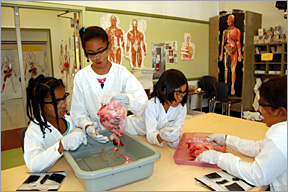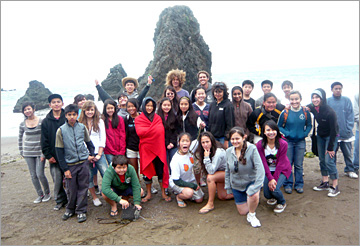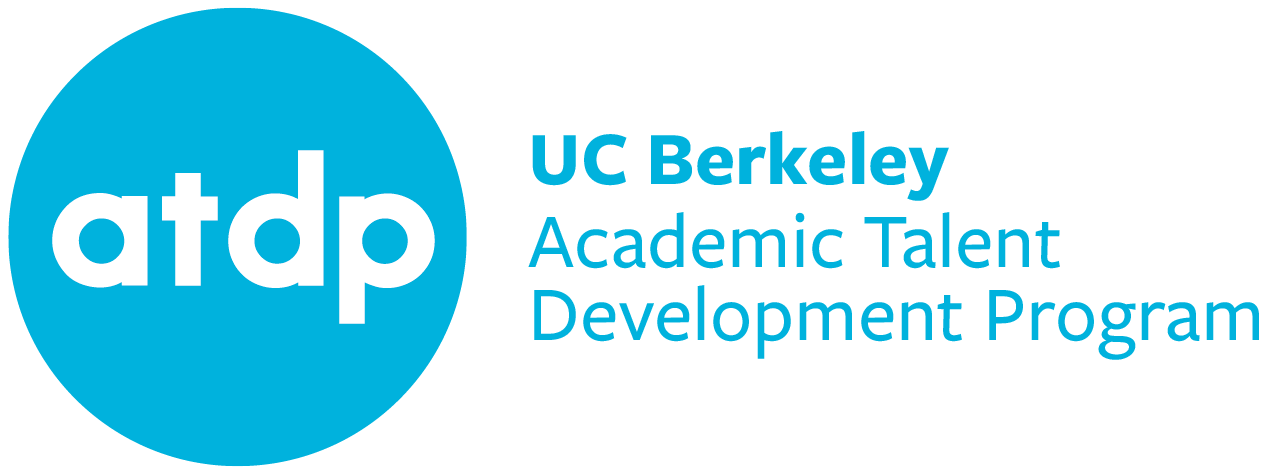Human Anatomy & Physiology (ED)
Patty Holman and Paul Bruno
We got up extra early one morning to pick up our specimens for the day: sheep hearts. Getting up early is never fun, but this time it was completely worth it. A couple of hours later the hearts were in the hands of be-gloved and be-goggled students finding all of the anatomical features we’d been talking about in class. First, we opened up the pericardia to get at the heart itself. Then we cut into the walls of the heart, found all of the chambers, and compared the muscularity of the different walls. And finally, as much for fun as for the educational value, we stuck our fingers deep into the hearts to trace the path that blood would travel through the vessels and chambers.On another day we did something a little less… bloody. Our question was, How does the music we listen to affect our ears? To find out, we did what good scientists often do: we built a model. A delicious model of the inner ear made of marshmallow and pasta, in fact. Then, with earplugs in place, the stereo set to “groove,” and the music blasting, we explored how the sound from the stereo could literally move parts of our ears so that we could hear it (and why it’s important to be safe when listening to loud sounds!). Then, of course, we ate our models. Not all scientists satisfy their curiosity and their sweet tooth at the same time, but that’s how we roll in Human Anatomy & Physiology.
 First-Year Japanese (SD)
First-Year Japanese (SD)
Junko Hosoi
Toward the end of the course, students in First-Year Japanese had tele-conference to Japan by using Skype, and talked to a couple of Japanese kids living in Japan. At the conference, ATDP students introduced themselves in Japanese: their presentation included their name/nickname, nationality, age, school grade, home location, hobbies, dis/likes, what they are good/bad at, and some information about their family members and pets. (Yes, they became able to speak this much in Japanese after only 6 weeks!) In the photo to the left, students practice making sushi in one class activity. Some students also played musical instruments, sang, and showed their artwork to make our conference fun. Japanese kids also introduced themselves and asked questions to ATDP kids after each presentation. One Japanese kid also showed his karate skills. It WAS fun, and we decided to keep in touch and keep having fun. That’s how our pen pal project began, with cooperation with Japanese adult volunteers. Now 13 ATDP students who took First-Year Japanese and several Japanese teenagers are participating in the pen pal project, using Google news groups. Here are the topics that students in the news group decided they would like to discuss (in Japanese!):
September: Get to know each other! Talk about yourself including your hobbies. October: Talk about your school subjects (What subjects do you study and what is your school schedule like? What subjects do you like or dislike? Do you do any extra curricular activity?) November: Tell Japanese friends about Thanksgiving in the States. Since it’s a unique American holiday, most of Japanese do not know about it. Tell them what you do, when and how you celebrate and with who. December: Christmas or the December holiday event is a big event in both U.S. and Japan. However, it seems that the ways to celebrate are different from each other. Why do many Japanese people celebrate Christmas although the Christian population in Japan barely accounts for 1%? January: Tell American friends about Japanese New Year’s Day. Tell them what you do, when and how you celebrate and with who.
Marine Biology (SD)
Nathan Kirk
 When my ATDP 2009 Marine Biology students conducted an in-depth exploration of the many fragile marine habitats throughout the class, learning that many of these ecosystems were at their tipping point, they were appalled and they wanted to know what they could do to help improve the quality of the world’s oceans. Toward the end of our class this summer we watched the Sylvia Earle TED video about the health of our oceans. The students were galvanized to take positive action. We identified possible steps and discussed everything from making shirts, picketing, passing out “seafood watch” cards, to forming online and physical clubs and networks to create a group(s) of energetic, passionate and driven stewards of the oceans. The students opted to build a network by creating clubs at their schools and forming an ATDP-based coordinating club for leaders.
When my ATDP 2009 Marine Biology students conducted an in-depth exploration of the many fragile marine habitats throughout the class, learning that many of these ecosystems were at their tipping point, they were appalled and they wanted to know what they could do to help improve the quality of the world’s oceans. Toward the end of our class this summer we watched the Sylvia Earle TED video about the health of our oceans. The students were galvanized to take positive action. We identified possible steps and discussed everything from making shirts, picketing, passing out “seafood watch” cards, to forming online and physical clubs and networks to create a group(s) of energetic, passionate and driven stewards of the oceans. The students opted to build a network by creating clubs at their schools and forming an ATDP-based coordinating club for leaders.
The ATDP-based club started with a Facebook page and has blossomed into (what I like to call) “mother ship meetings” where we discuss and coordinate activities of the school-based clubs. The organization is now called AMABAC (Association of Marine Activists: Bay Area Chapter) and we meet at UC Berkeley. We are currently creating themes for each month (this month is sea otters because we are now in the nationally observed sea otter awareness week [Ed.: this was when Nathan e-mailed Nina]) and each month will have presentations about the topic/theme (education component), an awareness component that focuses on educating others, and a community component where the club members can get together and do team-building activities, such as kayaking, surfing, going to the movies, etc. (in the photo above, students from last summer brave the early morning chill and fog at a tidepool somewhere north of the San Francisco Bay, along the Pacific coast).
Unfortunately, I just got a job working on a boat for the fall and spring that is docked in Ventura. However, I am still coordinating and leading the meetings (via Skype/iChat) but I am beginning to rely heavily on the students to collaborate, share responsibilities and continue the meetings/activism. In particular, I want to send a shoutout to Hana Wasserman who has taken on many extra duties that I would otherwise have performed and also to Hana’s mom Jane Nishio for her contribution of time and wisdom by being the official “responsible adult” at all of the club’s ATDP-based meetings.
I am very proud of these students as they have shown an incredible vision and drive to help protect the world’s ocean ecosystems, and to increasing their fellow students’ awareness of these issues.
